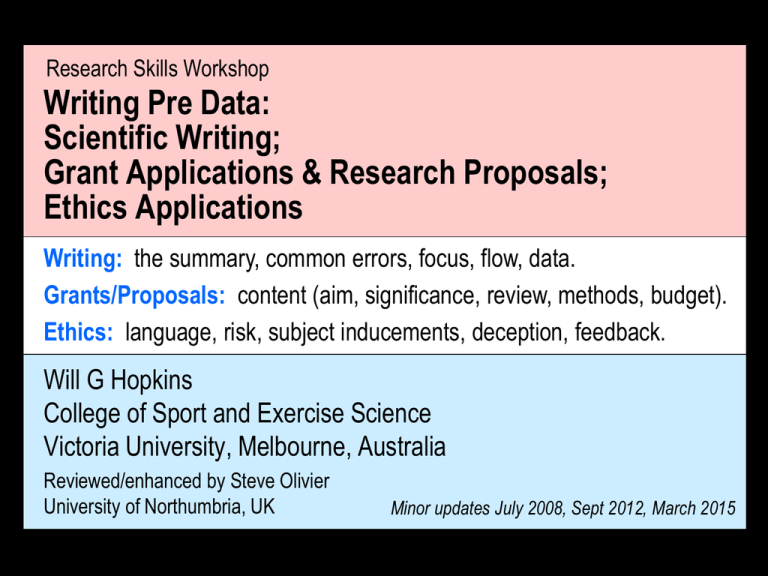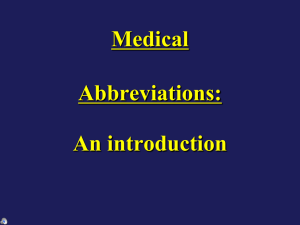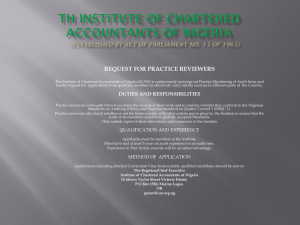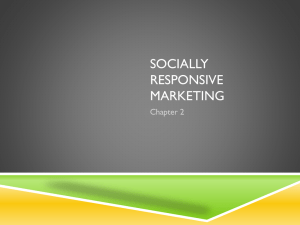Writing pre data
advertisement

Research Skills Workshop Writing Pre Data: Scientific Writing; Grant Applications & Research Proposals; Ethics Applications Writing: the summary, common errors, focus, flow, data. Grants/Proposals: content (aim, significance, review, methods, budget). Ethics: language, risk, subject inducements, deception, feedback. Will G Hopkins College of Sport and Exercise Science Victoria University, Melbourne, Australia Reviewed/enhanced by Steve Olivier University of Northumbria, UK Minor updates July 2008, Sept 2012, March 2015 Scientific Writing Your main aim is to make it easy for the reader to understand your ideas. Search a bibliographic database for what's known on the topic(s) in the document. PubMed for health. Google Scholar and SportDiscus for sport and exercise. Be obsessional about following any instructions. Impress reviewers with your ability to obey sensible rules. Justify any rule breaking. Be thorough, fussy, consistent, obsessive. Supervisors, editors and reviewers get angry about lack of attention to detail. The Summary or Abstract is the most important section. Write it first (along with the title). Rewrite it while/after you write the rest of the document. Include as much information as possible in the allowed space. Devote an appropriate amount of material to each section. • Common error: the background is either too short or too long. Include no material not already in the body of the document. Avoid abbreviations. Don’t make up any. Never state the results will be discussed or similar. Include no references, figures, or tables. Avoid these common grammatical errors: Ambiguous antecedent: This means… Misplaced modifier: When injured, we tested the athletes. Non-human agent: This review discusses… Double doubtful: The results may suggest… Avoid also... punctuation errors, especially it's and plural's too many statements in brackets parentheses (or brackets) within parentheses […(…)…] spelling errors abbreviations: do not invent any! technical terms (jargon) hyperbole, such as very, extremely, optimize awkward expressions passive voice, for example: It has been identified that... wasted words and clichés, such as the results showed that... wrong words, especially affect and effect subject or participant; use athlete, runner… repetition of words, phrases, ideas non-sentences one-sentence paragraphs Use of numbers Follow the required style. Otherwise, use these defaults… one, two, three… nine, 10, 11… • but 3 m, not three meters. The test lasted 30 s; it was a 30-s test. 1500 m, not 1500m • But use 35%, not 35 %, except for 15 ± 6 % (mean ± SD). • Also body fat was 17 %BM (percent of body mass), not 17%. Abbreviations for units never have “s”: 70 kg, not 70 kgs. Show data with the appropriate number of digits. • Standard deviations and the ± form of confidence limits need only two digits or sometimes only one. • The mean then has the same number of decimal places: 178.4 ± 7.3 or 178 ± 7; 1530 ± 170 (not 1534 ± 173). • Percents need only two digits: 13%, 1.3%, 0.13%. • Correlations need only two digits: 0.97, 0.43, 0.09, 0.00. • Avoid P values, but if you have to use them, show exact values (0.83, 0.09, 0.05, 0.01, 0.007, 0.0003), not P<0.05 or P>0.05. Aim for focus: Check that all material is in its most appropriate section. Have one main idea per paragraph. • Avoid two “however”s in one paragraph. Keep to the topic. • Don't generalize too far beyond the data. Aim for flow: List headings, subheadings, and topics within each section before you begin. Avoid unlinked ideas (non-sequiturs). Make a logical sequence of ideas within and between paragraphs. Reference most assertions. Qualify unreferenced assertions with apparently, may, I/we believe that… Get a critical colleague to give you honest feedback on a draft. Put the final document aside overnight then read it right through again before you send it off. Mini-test: correct the errors... The subjects (n=34, age 23.45 ± 5yrs, weight 72 ± 6.2 kg) were recruited from local clubs. We recruited 34 runners (age 23 ± 5 y, weight 72 ± 6 kg, mean ± SD) from local athletics clubs. This suggests the rate of change in heart rate response may be important. The rate of change of heart rate may therefore be important. The size of the responses depend on the size of the change in heart rate and also the LBNP. The response depends on change in heart rate and lower body negative pressure. This study looked at the effect changes of pressure had on heart rate. We studied the effect of pressure on heart rate. The results showed that there was no correlation between performance and skinfold thickness (r=0.342, p>0.05). The correlation between performance and skinfold thickness was small but non-significant (r=0.34, p=0.21). CONCLUSION: Based on this data, the athlete's performance was not effected by the supplement. CONCLUSION: The supplement had no substantial effect on performance. Grant Applications and Research Proposals Your institutional research office may be helpful. Abstract Summarize everything, not just the rationale. Aim/Purpose Describe what you hope to achieve. Usually the effect of X on Y or the relationship between X and Y. Do not "determine whether there is an effect", because there is always an effect. Significance/Benefits Explain the originality and the uses of the work. State that it hasn't been done before anywhere and/or on athletes/people in your country. • But make sure the novelty of the work is important. Mention potential academic advances. Emphasize unique local expertise, resources, or opportunities. Review of Literature Keep it focused. Cite papers by likely reviewers. Methods Describe and justify the design. It must be the best possible under the circumstances. Show a design figure or time line. Justify sample size using precision of estimation (confidence limits) and sample sizes in comparable published studies. If the granting body is conservative, show also a traditional sample-size estimate, even if it is unrealistically large. Be specific about what measure will determine what outcome. Describe or reference techniques and assays. Show that you understand the practical issues. Otherwise the reviewers will dismiss you with “dry lab!” Keep the size of the project manageable. Measure a few variables well, rather than many poorly. More variables or groups require bigger sample sizes. Include an account of any pilot work. Budget Be pessimistic about costs. Account for every item. Check on the availability and cost of existing resources. Check on the delivery time of purchases. Curriculum Vitae Rewrite it to enhance its relevance to the proposal. Ethics Applications Follow the instructions in your application form. Use plain language for the lay members of the ethics committee. There is no risk-free procedure. Get that across or you will be sued when things go wrong. Increase subject compliance by providing adequate compensation for their time and/or travel. If you use deception to avoid placebo effects, make sure it is of a kind that the subjects will accept when they find out about it at the end of the study. Try to arrange for all subjects to benefit. Crossovers are good. Commit to high-quality feedback/debriefing for subjects. This presentation is available from: Download it from Sportscience 7 (2003) via the Writing link.











